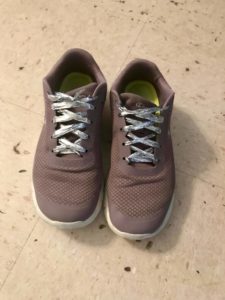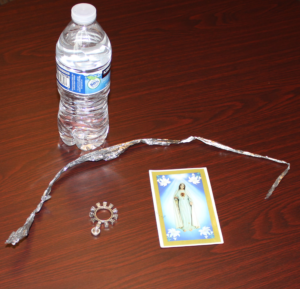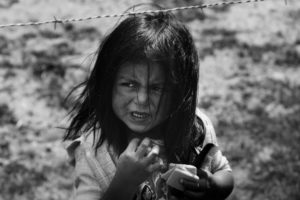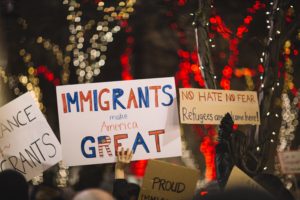I spent a week touring and working in respite centers along the southern border. While we were there, our team tried to help arrivals work through the trauma they had experienced, hoping to alleviate their intense anxiety. In this report, I walk you through the challenges faced by asylum seekers coming to the U.S. and the work Catholic Charities does to protect Oregon’s newest neighbors from further trauma resulting from separations and removal.
We worked at respite centers across the country, providing critical services to folks coming out of detention
It’s important to know that people crossing the US/Mexico border go through a number of different national detention systems before arriving at the respite center where we were. People are held in detention on both sides of the border, and some have been detained across multiple international borders as they’ve made their way north from the Northern Triangle countries (Honduras, Guatemala, and El Salvador). Once released from detention, these people are taken to respite centers in border towns, most of which are run by a Catholic Charities affiliate. These centers are where our Oregon teams have worked.
Folks stay in the respite centers anywhere from a few hours to a few days (very occasionally, a week or more) as they prepare for their trip to loved ones in the interior of the U.S. While respite centers do their best to provide immediate emergency assistance, the groups that arrive can have fifty or more people in them, and the whole center looks like a kind of contained chaos.
First, they enter a registration room, where Catholic Charities team members take their names and destination city and explain what they can expect as far as the process goes. While waiting for their turn with the registration person, adults receive water and children receive Pedialyte. Often, this is the first drink people have had in 24 hours or more.

My visit to the Ropa Room
The “ropa room” is well-stocked with donations from across the country, and people have some time to sort through racks of clothes and supplies to find something that fits. Once they find something, most people throw away the old clothes they have been traveling in. Usually, folks have been in the same clothes for weeks at a time; needless to say, their old clothes are filthy from the various perils they faced along the way.
Giant trash bins quickly fill up with soiled clothing and strips of mylar torn from the detention center “blankets” to make basic makeshift items. This demands a constant trek between the ropa room and the industrial dumpsters at the back of the property. The ropa room has clothing for every age and size, from infant onesies to XXXL men’s pants. The youngest child I personally worked with had just turned five months old. His little onesie had once been white, but two weeks of traveling had stained it tobacco brown. His mother had to drop their bag carrying changes of clothes at the Guatemala border while fleeing from cartels.
When the family fell into a leach field in central Mexico – this was after they’d dropped their bag of clean clothes – they were forced to stay in the same clothes they had left in, now stained with human filth.
The baby had angry pink splotches on his arms, neck, and chest, presumably because of this exposure. He also had small scratches on the back of his head, evidence of his nights spent on cold concrete floors in detention; fortunately, we were able to get him into a medical clinic right away.
After visiting the “ropa room,” people typically take showers. Locker-room-type showers separated by gender occupy different floors in the center. Catholic Charities provides a wide variety of supplies to people: towels, soap, shampoo, razors, shaving cream, toothbrushes, deodorant, and a number of other hygiene supplies. Volunteers constantly hum in and out of the shower rooms during lulls to restock and clean.
Many people coming into the respite center are in a state of shock. So much exposure to saturated brutality causes a cognitive hiccup that can make navigating even the simplest task seem insurmountable. We do what we can to keep people informed on what to expect and what is going on to try to reduce any unnecessary trauma.
After showering, most people go to the small cafeteria at the back of the respite building to eat. The Knights of Columbus and senior center volunteers dart in between the tables delivering heaping paper plates of beans and chicken. The Bishop of Laredo frequently arrives just before mealtime to hand out prayer cards and rosaries, which are confiscated at the border, and to offer a blessing to newly-arrived people.
Mealtimes are also a time when people are reunited with friends or neighbors with whom they had been traveling. Most are separated while in detention. At least once a day you hear a gasp or a sob or an incredulous laugh as people are finally able to confirm with their own eyes that their friend or neighbor indeed made it to the U.S. alive.
Health and human dignity at the border
Health and human dignity are not being protected. One of the largest roles played by the respite center is to be a safe and welcoming place for people trapped in the middle of one of the worst humanitarian crises in the Americas. A part of being that safe space – or those safe people – is to bear witness to the atrocities witnessed and lived by the people we serve.
The violation of human rights taking place in U.S. detention centers is catastrophic. People are denied the most basic of dignities. Going to the bathroom, having access to hygiene products and food are luxuries in detention.
One teenage girl disclosed that ICE would take food from children as young as three as punishment for not understanding or following directions. Another told me when she and her mother were waiting on an ICE bus that had stopped on a bridge (likely the international bridge between Mexico and the U.S.), ICE had told them they were going to open the door and throw them to the cartels who were waiting outside to rape them.
On our second day, there was a young woman who appeared to be six or seven months pregnant. She said she had been traveling for two weeks with her niece and nephew who were 14 and 17, respectively. Her sister had made the trek to the U.S. some years before to provide for the family, and she was now following, her sister’s kids in tow. While in detention, the kids were separated by ICE agents and disappeared into the crowd of bodies smashed into the narrow hallway. ICE would not disclose the location of the children. By the time she reached us, she was panicking. Sobbing, and with the support of one of our team, she had to call her sister and inform her that her children were gone.
Later, the same young woman approached me after she had showered and changed. She handed me a small white paper bag, carefully folded along its seams. She said the medical staff in the detention center had given her some pills to take to help her with a supposed UTI.
She didn’t know what it was, and the doctor in detention wouldn’t give her any more information, so she decided not to take it. She felt very ill. We took the bag and took her to the medical clinic, handing the bag over to the volunteer M.D. An hour later, the doctor, tight-lipped and disgusted pulled me aside. The medication given to this young pregnant woman in detention would have caused a miscarriage had she taken it as instructed.
The face of migration is changing
What’s happening on the border may be the most publicized, but it’s only a symptom of a widespread and hugely complex humanitarian crisis.
People forced to the U.S./Mexico border as immigrants or asylum seekers are overwhelmingly from the Northern Triangle Countries of Guatemala, Honduras, and El Salvador. These countries are ranked among the 10 most violent in the world, with Honduras representing the world’s highest murder rate, with El Salvador and Guatemala placing 5th and 6th, respectively.
While the history and politics of the crisis are far too in-depth and complex for me to cover in this blog, it is important to know that it is the direct result of U.S.-backed civil wars and military interference going back to the 1980s.
Due to the intensity of the violence, families with children are fleeing the region at unprecedented rates, changing the face of a migration crisis that has existed for decades. Corruption, extortion, drug and sex trafficking, and kidnappings force people to make an impossible decision: stay home and be maimed or killed or make the trek to the U.S. and hope to survive. Every family I worked with who had teenage children all reported the same thing; they left so their boys couldn’t be forcibly (and often violently) brought into gangs or so their girls weren’t victims of gang rape and other violence at the hands of gangs.
If You Are Poor, You Are Deported
After a harrowing journey of days to weeks, people are crushed through the U.S. border like meat through a grinder. Many are turned away, and with the Remain in Mexico Policy, many are shipped to Chiapas in Mexico to await their asylum hearing. The lucky few who get through are released with already active deportation cases. Prior to being released, they are issued a Notice to Appear and must report to immigration officials at their final destination. More than 90% of people released with a Notice to Appear show up for their immigration appointment.
Having survived the often-deadly trip to the U.S./Mexico border and braved the chaotic, Kafkaesque U.S. detention system, the nightmare is far from over. Once they arrive in their final destination, people are left to navigate the complex immigration system in the interior of the U.S.
“Unauthorized” people cannot work or receive benefits and must find a way to survive on literally nothing. They can try to find a lawyer to help them plead their case, but waitlists for low-cost or pro bono attorneys are years long. The uncertainty people face following their arrival is nothing short of horrific. People live in a constant state of fear and, more often than not, perpetual poverty and deprivation.
People can be snatched away from their families and returned to their countries where, usually, certain death is waiting. This is happening in Oregon. Today. Tomorrow. Every day. People seeking safety and refuge in Oregon are forcibly separated from their families, from their children. Without an attorney, asylum seekers have a 6% chance of winning their case. Without the resources to pay for an attorney, people can be grabbed up and taken away any time, without warning. If you are poor, you are deported.
What if Mom and Dad Don’t Come Home?
When a child’s parents are suddenly deported, what happens to the child depends. In many cases, the family will make the decision to have children go to a family member or friend still in the U.S. Often, this happens quietly and under any kind of state radar. Some make the choice to have their children return to their country of origin. For families without family or friends in-country, children will become DHS involved and are often placed into state custody.
Parents or caregivers detained by ICE are not allowed out of detention to attend a custody hearing. Since they are then a “no-show,” they are dubbed “non-compliant” or “failure to appear,” which the courts treat as neglect. At that point, the child becomes a ward of the state while their parent or guardian, ready and willing, is kept from them.
Under the current administration, the estimated number of children entering foster care due to immigration issues is 15,000.
A disaster of our own making
Mass deportations have already had huge effects on hundreds of children across the country. When a parent disappears, children are left at school or return home to empty houses. Young children and teens alike are left to their own devices until arrangements can be made on their behalf, which sometimes involves living without an adult caretaker for several weeks.
This phenomenon has huge consequences for the physical and mental health and safety of these kids, as well as access to food and other necessities for long-term health. The threat of mass deportations has already changed the way undocumented families navigate their world.
Sending children to school with passports, living deeper and deeper underground, not having access to healthcare or education are just a few of the things people have to deal with. They are under siege.
Public charge will not affect undocumented people or their children for the most part. Because most undocumented people don’t have a pathway to citizenship or LPR status, public charge will not apply to them. Unfortunately, many people in the community don’t know that.
Public charge is complex and confusing, even for professionals working in the field. Many people are actively opting out of services for their children that the kids have a right to, due to fear of arrest or deportations around the public charge issues. Catholic Charities and other community organizations are engaged in education campaigns around the state to ensure community members are accurately informed about public charge.
This immigration crisis is a disaster of our own making and a despicable legacy to leave our children and grandchildren.
Catholic Charities Works to protect the dignity of local immigrants and asylum seekers
Catholic Charities’ Immigration Legal Services team helps to protect Oregon’s migrant community by expanding access to the kind of legal representation that gives folks a chance to navigate the confusing immigration system successfully.
Since the few who make it into the U.S. already have active deportation cases, they must report to immigration officials at their final destination. 90% of people released with a Notice to Appear show up for this appointment, and because Catholic Charities and other local agencies provide greater access to legal assistance, more people avoid removal.
The attorneys across the state who provide thousands of hours of pro bono legal assistance every year on behalf of Catholic Charities provide a critical service to this vulnerable population. Those who are authorized to stay in the U.S. gain access to employment opportunities, public assistance, and reprieve from the fear that they (or their family) will be removed.
Those who continue as clients of Catholic Charities also gain access to intensive case management from field experts who can help them find employment, access affordable housing, and use local transportation, among other services that make communities safe and accessible to vulnerable populations.



